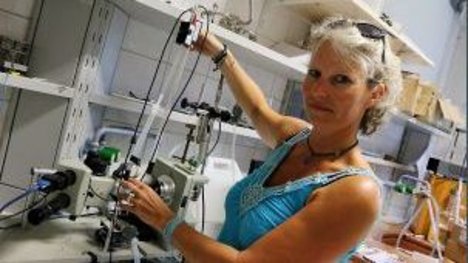Ultrasound device counts gas bubbles in the blood

Grit Oblonczek is talking about gas embolisms and patient safety in connection with the ultrasound meter which GAMPT mbH has developed. “Gas bubbles,” says the physicist, “can block vessels in the body in the same way as blood clots do.” In major operations, such as open heart surgery or during transplantations, the bloodstream runs through a CPB pump. This can lead to an increased concentration of microbubbles, which can be responsible for postoperative neurophysiological damage and even cardiac infarction and strokes. Specialist heart units and clinics, which have recognised this risk, are the customers of the innovative company based in Merseburg. Ten years ago, it launched the Bubble Counter on the market.
Grit Oblonczek stands in front of three full packing cases. The one with the shortest journey ahead of it is addressed to the Martin Luther University of Halle-Wittenberg. The content: An ultrasound training device with medical application. As well as the study of medicine, the university also offers a degree in medical physics. “Ultrasound included and as related to practice as possible,” says Grit Oblonczek. Together with the device, her company is also supplying models of the chest, arm and eye. They are made of materials, which are well suited to ultrasound examinations.
“The other two devices are going to Algeria and the USA,” says Grit Oblonczek as she passes the boxes, which she still has to prepare for customs. She continues through the production premises of her medium-sized company. On the workbenches, things are being drilled and screwed, circuit boards are being fitted and installed in the housings. The high-quality ultrasound meters are produced to order. The orders come from the growing field of training and from sound field metrology, among others, in order to carry out quality assurance and inspections in industry and medicine.
Since its foundation, GAMPT has been conquering the market of medical engineering with the Bubble Counter, a measuring device which can calculate the number of microbubbles and their size between 5 and 500 micrometres in fluid.
We have arrived in the calibration laboratory. This is where the microbubble detection probes belonging to the Bubble Counter are hanging. When they are in use, they send ultrasound into the bloodline at certain measuring points. Depending on the size, the gas bubbles send the sound back in different strengths, so that the measuring device can calculate the number of microbubbles and their diameter.
GAMPT is the abbreviation for “Gesellschaft für Angewandte Medizinische Physik und Technik” (Society for Applied Medical Physics and Technology). Its founders were scientists at the “Institute for Applied Medical Physics and Technology” at the University of Halle and simply substituted a letter. The impulse for the founding of the company in 1998 was an order to develop a device which could count the gas bubbles in the blood. A German company wanted to have such a device for research purposes. It was no coincidence that the order went to Halle. The development of ultrasound technology has been promoted here for decades, and the university also has a good reputation in this field.
From the prototype, the Bubble Counter was developed. “When a new customer purchases a Bubble Counter from us, we carry out the training ourselves in the operating theatre,” says Grit Oblonczek. The physicist entered the company in 2008.
She is responsible for marketing and sales at GAMPT. The export proportion of production is now more than 60 percent. The ultrasound devices are sent to Scandinavia and Russia, to the Netherlands and Switzerland, Canada, Great Britain, Spain, Italy, the USA, Saudi Arabia and Asia, among other places.
“When a new customer gets a device from us, we carry out the training ourselves in the operating theatre,” says Grit Oblonczek. Specialist heart units and university hospitals throughout Germany and overseas are interested in the Bubble Counter. “They come across us at trade fairs, but especially through the testimonials of our customers,” says the head of sales, mentioning the Martin Luther University and Great Ormond Street Hospital in particular.
At the moment, the GAMPT scientists are “modernising” the internal workings of their Bubble Counter. The next generation of the ultrasound device will measure more quickly, record even more data and be able to evaluate this in even smaller time frames.
Of the 20 employees in the company, 15 are scientists. And so it stands to reason that the company sees itself as a “problem solver”. Meaning: At the request of the customer, GAMPT deals with basic research and develops sensors, modules and complete systems for companies from the medical and technical fields.
We also develop projects with scientific facilities and other companies,” says Grit Oblonczek, emphasising that they do not consider themselves to be competitors in the region of Halle where a number of ultrasound companies are based. The accumulated expertise is used here to complement each other.
With the Charité – Universitätsmedizin teaching hospital in Berlin, a bed with in-built loudspeaker is currently being developed, whose vibrations stimulate the body tissue to compress. These are measured using ultrasound and provide information about the elasticity of the tissue. The innovative feature here: “Ultrasound can still penetrate into body parts, which the doctor can no longer manually feel,” explains Grit Oblonczek. For example, in the future, this bed could be used to measure the elasticity of the heart wall in a patient’s beating heart. Non-invasive tissue analysis of the liver will also be possible using ultrasound.
Author: Kathrain Graubaum (text/photo)
Captions: Grit Oblonczek shows the Bubble Counter’s ultrasound probes in the calibration laboratory of GAMPT. They measure the number and size of gas bubbles in the blood.
